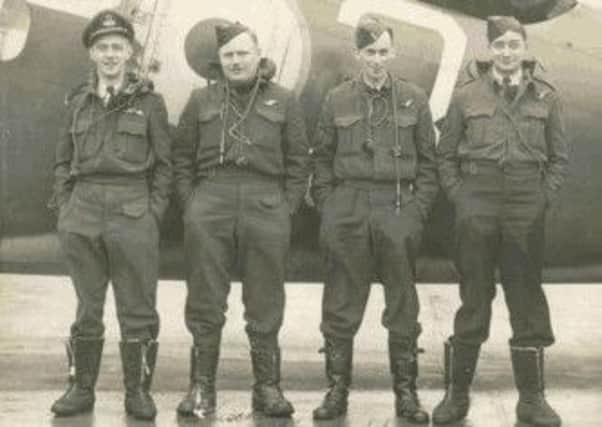Obituary: Flight Lieutenant Ted Bracken, wartime pilot and NHS director


Ted Bracken, who has died aged 91, was one of the first pilots to fly over the Himalayas while supporting Allied forces in the Burma campaign of the Second Word War.
He guided his RAF aircraft over the world’s highest peaks from India to China on 34 pioneering but hazardous missions in the fight against the Japanese from 1944-45.
Advertisement
Hide AdAdvertisement
Hide AdWhile Europe celebrated peace, the 14th “Forgotten” Army was still engaged in fierce battles throughout Burma against an enemy that fought to the death.
The Allies were forced to consider other methods to supply Chinese and other friendly forces in the Far East after the Japanese cut off the main reinforcement route.
Despite the vast Himalayan mountain range appearing all but impassable, Bracken’s 52 Squadron, equipped with Dakota transport planes designed in the 1930s, was handed the challenge. Bracken had joined the RAF at 19 with a welcoming letter from the Secretary of State for Air, who warned: “The final overthrow of the powers of evil now arrayed against us depends on you and your comrades.
“You will be given the best aircraft and armament that the factories of Britain and America can produce. Equip yourself with knowledge of how to use them. Good luck!”
Bracken’s twin engine, propeller-driven Dakota and its crew faced enemy action and terrible weather conditions, such as severe icing and air pockets which threw the plane up and down hundreds of feet in seconds. After flying in a monsoon, he wrote: “At some stage I was aware of a size ten desert boot (my navigator’s) around two inches from my right eye.
“I remember being fascinated by the port wing bending and flapping like a stork’s wing. Movement was vicious and on occasion like being jolted as if smashing into a wall.
“Rudder and stick were moving as they were forced and I could make no impression on them. At one point I looked at the speedo but where was the needle? Not to be seen!
“There I was, possibly upside down and nothing on the clock! After what seemed to be a lifetime of tumbled gyros we shot out of the clouds into the clear, appearing to balance on one wingtip, and very surprisingly we were flying south – back towards Rangoon.”
Advertisement
Hide AdAdvertisement
Hide AdOn another mission he enjoyed “a rare, unforgettable view of the Everest block clearly seen over my left shoulder while listening to the American radio network”.
The first flight over the Himalayas had only been achieved three years earlier and at one point he was given a school atlas for navigation.
Bracken said flying over the lofty peaks contradicted all theories of flight and could lead to “utter disbelief”.
In an article for the Scottish Saltire Aircrew Association about his first solo flight over The Hump, as aircrews called the range, he wrote: “The weather was not really encouraging as the aerodrome was closed with high winds and heavy rain.
“Not wishing to appear ‘chicken’ I decided to go for it, despite noting a line of unmoving American aircraft with the painted squadron crest stating: ‘We fly when the birds walk’.
“Shortly after take-off we flew into a heavy storm with hailstones the size of golf balls threatening to smash the windscreen.”
The son of a goldsmith, Edward Alfred Bracken was born in Stoke Newington, London, on 21 January, 1922. The family moved to Scotland when his father was sent to Leslie in Fife with the De La Rue company, which manufactured fountain pens with gold nibs.
He was educated at Leslie primary school and Kirkcaldy High School, where he was a good all-round sportsman and played rugby. He left school at 17 and briefly became a law clerk in Perth.
Advertisement
Hide AdAdvertisement
Hide AdAfter the outbreak of war he enlisted in the Home Guard before joining the RAF and passing selection for aircrew. He was awarded his pilot’s “wings” in Canada through the Empire Training Scheme and was posted to the Far East, serving in India, Burma and China.
Bracken’s Himalayan flights were so pioneering that before leaving the RAF he plotted and flew the first routes for British airline flights from Rangoon to Bangkok, Saigon and Hong Kong. He married his sweetheart, Jean, after the war at St Ninian’s Cathedral in Perth and they set up home in Arbroath, later moving to Inverness. The final move was to Edinburgh.
Bracken stayed in uniform as a reservist in 603 (City of Edinburgh) Squadron, Royal Auxiliary Air Force, at Learmonth Terrace and Pitreavie in Fife. He retired from his civilian career as director of supplies for NHS Lothian.
A friend flew over the Himalayas to Hong Kong in recent times and Mr Bracken asked him what he thought of The Hump.
His friend was puzzled and Bracken recalled: “It then dawned on me that he had flown at 37,000 feet, while we had scrambled to get to 17,000 in our old Dakotas to avoid the bulk of the peak.”
A holder of the Burma Star along with other campaign and service medals, Bracken also plotted and recorded civilian and military air crashes throughout Scotland as a hobby.
He loved singing and dancing, the company of others, comedy, the garden, jazz, good food and fine brandy. Sport was also a passion. He had been a member of Leslie Golf Club and Mortonhall Golf Club and supported both Arsenal and Raith Rovers.
Jack Burgess, a fellow war veteran and member of the Scottish Saltire Aircrew Association, said: “Ted was a very much loved member who always had a cheery word for everyone. He is sorely missed.”
Bracken, who was predeceased by his wife, is survived by a sister, Marion, sons Edward and Steve, daughter Bev, six grandchildren and three great-grandchildren.